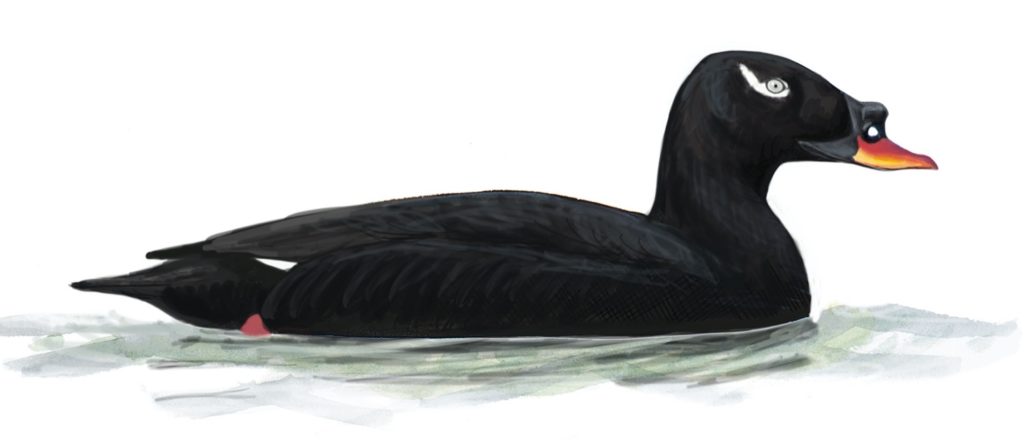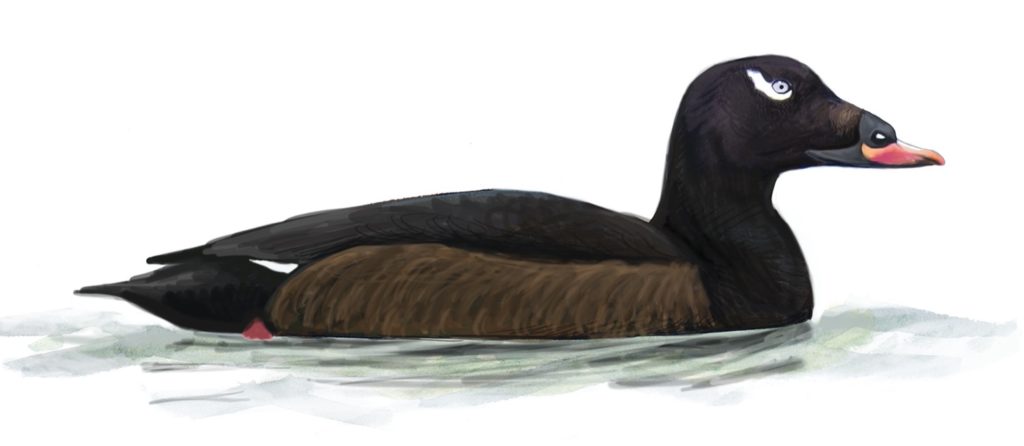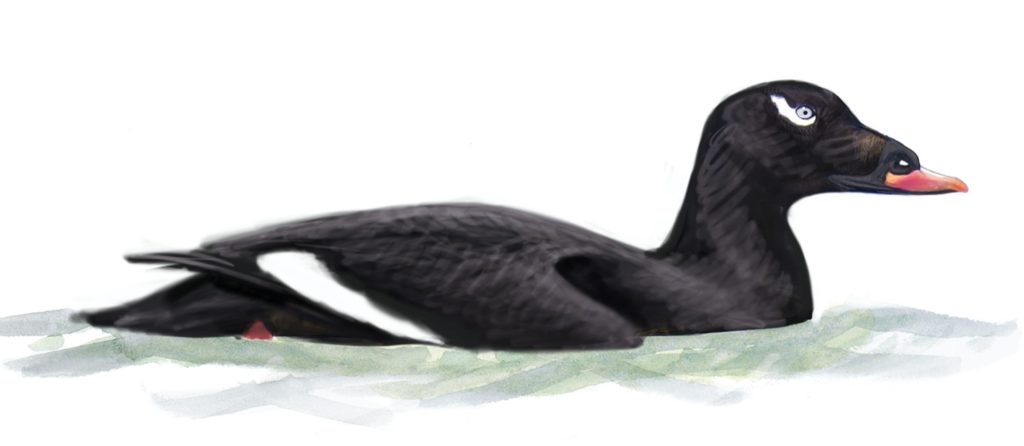Stejneger’s Scoter is the Siberian counterpart of White-winged Scoter, only recently recognized as a separate species. The two species are very similar in all respects, and only adult males can be identified readily in the field. Stejneger’s is considered a very rare visitor to western Alaska, but my experience in Nome in 2021 suggests that it is regular there in small numbers, and probably nesting.
Stejneger’s Scoter

- head more oval, blocky, with forehead convex, giving the impression of a large solid black area between eye and bill
- flanks all black (but see below for pitfalls)
- knob on bill more prominent
- bill tip orange with yellow along lower edge, appearing more colorful and more obvious at a distance than on White-winged Scoter
White-winged Scoter

- head more tapered, with forehead concave; the indentation on the forehead profile, and (often) a faint brownish sheen near the base of the bill creates a different impression from Stejneger’s
- flanks brownish (but see below for pitfalls)
- knob on bill less prominent
- bill tip dull reddish blending to yellow near nostril, appearing less colorful than on Stejneger’s Scoter
Pitfalls of judging flank color
Flank color is the main first indication of species, and the best way to quickly scan for potential Stejneger’s at a distance, but it is essentially a one-way field mark. Seeing brown flanks confirms a White-winged Scoter, as adult male Stejneger’s never shows brown flanks. But White-winged can sometimes appear to have black flanks. Seeing black flanks is a good starting point but requires further investigation. It should also be noted that first spring males of both species have variably blotchy brown flanks, so this feature is only useful for adult males.
Wings open
Scoters use their wings for propulsion under water, and when actively foraging they keep their wings open when they are at the surface between dives. When the black wings are held away from the sides of the body they obscure the telltale brown flanks of White-winged Scoter, and make both species appear to have black flanks.
If you can see a big white band (the white secondaries) this means the wings are open and you will not be able to see the real flank color.

Lighting
The brown flanks of White-winged can be very obvious in bright light, but with a bit of shadow the flanks appear black (eg in low angled light with the body turned away from the light). The apparent color of the flanks changes dramatically with lighting, and you must constantly consider the effects of lighting, study other birds to get a sense of the current effects, and watch an individual bird for an extended period to confirm the flank color at different angles.
Identifying a non-adult-male Stejneger’s Scoter
Adult males differ from White-winged in all of the details described above, but on females and immature males many of those differences are reduced or absent, making identification much more challenging.
Ageing and sexing: Adult males have body plumage essentially all black except for a small white crescent behind the eye, bill colorful and with ornamental knob, and iris white. They become slightly drabber in “eclipse” plumage in summer, but still readily identifiable. First year males develop a variable amount of black body plumage and bright bill color by spring. Females are always all brownish with white head spots and with the bill smaller than on males and all grayish.
Immature males are identifiable with close views as they show some features of adult male head and bill shape and bill color. Overall their appearance is essentially intermediate between female and adult male, and variable. One seen 03 June 2021 at Nome was similar to adult male but with brownish wings, smaller and indistinct white eye mark, smaller bill knob and drabber bill tip, less deeply black head and faintly mottled plumage. Identifiable as Stejneger’s Scoter by head/bill shape and bill color.
Females of the two species are apparently identical in plumage and bill color. They might be identifiable with exceptional views based on details of bill and head shape, but this is subjective and variable. First year female averages slightly smaller bill than adult. Further study of potential differences in the shape of the feathered border at the base of the bill, the shape of the nostril, or other bill details might reveal some reliable distinguishing features.
Status in North America
Stejneger’s Scoter was first detected in North America at Gambell, Saint Lawrence Island, Alaska, in 2002, considered a subspecies of White-winged Scoter at the time. It was listed as “casual in late spring in … Alaska” when it was elevated to a species by the AOS in 2019. But despite a general lack of awareness of the species, there was a steadily growing number of records in western Alaska, as well as winter records of adult males photographed in California and Montana, suggesting that Stejneger’s Scoter would eventually prove to be regular in North America. My own observations at Cape Nome, Alaska, in May-Jun 2021 found that the species is regular in small numbers and almost certainly nesting nearby.
Careful study of scoters there from 30 May to 3 Jun 2021 revealed one to at least six Stejneger’s daily, with quite a bit of turnover. Stejneger’s were far outnumbered by White-winged Scoters, but among all of the white-winged-type scoters that I was able to identify to species, at least 10% were Stejneger’s! Hundreds more white-winged-type scoters were visible farther offshore, too far away to distinguish White-winged from Stejneger’s, so the total number of Stejneger’s Scoters in the area was undoubtedly much higher than the few that I was able to identify.
The scoters offshore at Cape Nome at that time were almost all adult males, and the few females present attracted a lot of attention from the males. I assume these males were all staging offshore during the early phases of the breeding cycle, and probably dispersed to nesting and/or molting areas after a few more weeks. The first Stejneger’s Scoter that I detected was a male accompanying and defending a female scoter that I feel confident was also a Stejneger’s. Over the few hours that I watched, males of both White-winged and Stejneger’s scoters landed nearby and attempted to approach the female, but were driven away by the accompanying male Stejneger’s. Over the course of my observation there were always one or two male Stejneger’s Scoters swimming within 100 feet of this pair, while male White-winged Scoters were less persistent. It was impossible to keep track of how many male Stejneger’s Scoters came and went that morning, and my estimate of six was a conservative total.
Finding a Stejneger’s Scoter in Nome
It’s hard work. The main challenge of finding a Stejneger’s Scoter in Nome, Alaska is simply seeing one well enough to discern the key features. Some observers are lucky enough to find Stejneger’s Scoter swimming right next to the rocks at Cape Nome. Most of us have to settle for more distant views that require a good telescope and a lot of time. I saw a couple of Stejneger’s Scoters by looking south and west from the rocks at the tip of Cape Nome, but the most reliable area was just west of Cape Nome, offshore from the long sandy beach. Watching from the roadside opposite the quarry entrance (Google Maps link), or from a pullout a little farther west (Google Maps link), provided the best results.
My method was to scan the water to pick out small groups of scoters, and then study the closest ones through the telescope. But even these birds were usually quite distant, and seeing the features well enough to feel confident about the identification could take many minutes of study. I quickly learned to give up on birds that were just a little too far away, and to go back to searching for closer individuals. During the week that I was there a diligent search always produced an identifiable Stejneger’s Scoter in less than an hour of scanning. The birds move around quite a bit, so waiting and watching for a couple of hours will greatly increase your chances of finding one close enough to identify.


Very interesting and great you point out the field marks in your illustrations but also warn of the pitfalls of using flank color alone to help ID. Nice to see the blog going again in the Spring! Always learn from every post you make.
My group was on site on June 3, 4 and 5th. 2021. We preformed several sea watches over four days. White-wing Scoters were found, however we struggled to pull out a Stejneger Scoter to lay down a confident check mark. There was a moment when a WWSC / STSC sp. flew pass Cape Nome during the evening sun, this bird’s bill lite up, per your words, “bill tip orange with yellow along lower edge, appearing more colorful and more obvious at a distance than on White-winged Scoter” but offered us little time to study the bird. The check box remains unchecked. I’m back on May 27, 2022 leading two small six person / birder groups. We’ll start Friday night with a sea watch. Offer us some luck for this adventure..
I have several pics of a Scoter which I think is White-winged. But someone commented can’t see the bill feathering to rule out Stejneger’s (my pics are not the clearest).
It it is a Stejneger’s, it will be considered out of range because I’m in Alaska.
No one else commented, so I’m at a dead end for true identification.
Good discussion and as always, nicely illustrated. Stejneger’s Scoter seems as numerous at Nome as at Gambell, although this year, we could only find deglandi. But folks are primed and sometimes overly anxious to find Stejneger’s and I feel that many are misidentified. You might point out the Western Birds publication (available on-line for free) that details status and has good published photos of the first one identified at the point at Gambell from 1-3 June 2002 (Western Birds 43:220-228). Subsequently, it turns out an earlier one had been photographed in the Nome area. I think the sub-ocular white mark is an under appreciated mark. It is longer on Stejneger’s, but it is more than that, it is something about the shape, maybe in combination with the head shape? Also, Aaron Lang pointed out a good way to look at birds in flight, assuming they are photographed. Adult male Stejnegers’s has that shield go vertical up from the base, while it slants back a touch and is more rounded in deglandi. I have found it useful in resolving birds (adult males) that have flown by. Of course the identification is after the fact. I’m not sure I have ever seen an SY male of any scoter in western Alaska. This year (2022) I was surprised to count 22 Surf Scoters on the day (5 June) we were at Cape Nome and 78 Black Scoters. Our count of White-winged Scoters was 30, most of which were close enough to rather easily separable as that species. Yes, the blackness of Stejneger’s almost with a shiny sheen stands out.
I will add that the CBRC did not accept the Santa Cruz, CA record of the Stejneger’s Scoter, an adult male. A photo was published in the appropriate CBRC report (Western Birds 51:221-227, published color photo p. 232) This 3-6 decision surprised me and I dissented from the majority.